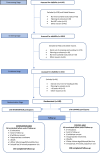Enhanced peer-group strategies to support the prevention of mother-to-child HIV transmission leads to increased retention in care in Uganda: A randomized controlled trial
- PMID: 38640123
- PMCID: PMC11029615
- DOI: 10.1371/journal.pone.0297652
Enhanced peer-group strategies to support the prevention of mother-to-child HIV transmission leads to increased retention in care in Uganda: A randomized controlled trial
Abstract
Introduction: Despite the scale-up of Option B+, long-term retention of women in HIV care during pregnancy and the postpartum period remains an important challenge. We compared adherence to clinic appointments and antiretroviral therapy (ART) at 6 weeks, 6, and and 24 months postpartum among pregnant women living with HIV and initiating Option B+. Women were randomized to a peer group support, community-based drug distribution and income-generating intervention called "Friends for Life Circles" (FLCs) versus the standard of care (SOC). Our secondary outcome was infant HIV status and HIV-free survival at 6 weeks and 18 months postpartum.
Methods: Between 16 May 2016 and 12 September 2017, 540 ART-naïve pregnant women living with HIV at urban and rural health facilities in Uganda were enrolled in the study at any gestational age. Participants were randomized 1:1 to the unblinded FLC intervention or SOC at enrolment and assessed for adherence to the prevention of mother-to-child HIV transmission (PMTCT) clinic appointments at 6 weeks, 12, and 24 months postpartum, self-reported adherence to ART at 6 weeks, 6 and 24 months postpartum and supported by plasma HIV-1 RNA viral load (VL) measured at the same time points, retention in care through the end of study, and HIV status and HIV-free survival of infants at 18 months postpartum. The FLC groups were formed during pregnancy within 4 months of enrollment and held monthly meetings in their communites, and were followed up until the last group participant reached 24 months post delivery. We used Log-rank and Chi-Square p-values to test the equality of Kaplan-Meier survival probabilities and hazard rates (HR) for failure to retain in care for any reason by study arm.
Results: There was no significant difference in adherence to PMTCT clinic visits or to ART or in median viral loads between FLC and SOC arms at any follow-up time points. Retention in care through the end of study was high in both arms but significantly higher among participants randomized to FLC (86.7%) compared to SOC (79.3%), p = 0.022. The adjusted HR of visit dropout was 2.4 times greater among participants randomized to SOC compared to FLC (aHR = 2.363, 95% CI: 1.199-4.656, p = 0.013). Median VL remained < 400 copies/ml in both arms at 6 weeks, 6, and 24 months postpartum. Eight of the 431 infants tested at 18 months were HIV positive (1.9%), however, this was not statistically different among mothers enrolled in the FLC arm compared to those in the SOC arm. At 18 months, HIV-free survival of children born to mothers in the FLC arm was significantly higher than that of children born to mothers in the SOC arm.
Conclusions: Our findings suggest that programmatic interventions that provide group support, community-based ART distribution, and income-generation activities may contribute to retention in PMTCT care, HIV-free survival of children born to women living with HIV, and ultimately, to the elimination of mother-to-child HIV transmission (EMTCT).
Trial registration: NCT02515370 (04/08/2015) on ClinicalTrials.gov.
Copyright: © 2024 Amone et al. This is an open access article distributed under the terms of the Creative Commons Attribution License, which permits unrestricted use, distribution, and reproduction in any medium, provided the original author and source are credited.
Conflict of interest statement
PM received funding from NIH/Eunice Kennedy Shriver National Institute of Child Health and Human Development (NICHD) grant # IR01HD080476-01.
Figures
Update of
-
Enhanced Peer-Group strategies to support prevention of Mother-to-Child HIV transmission leads to increased retention in care in Uganda: A Randomized controlled trial.medRxiv [Preprint]. 2023 Apr 17:2023.04.15.23288495. doi: 10.1101/2023.04.15.23288495. medRxiv. 2023. Update in: PLoS One. 2024 Apr 19;19(4):e0297652. doi: 10.1371/journal.pone.0297652. PMID: 37131665 Free PMC article. Updated. Preprint.
References
-
- World Health Organization. (2012). Programmatic update: use of antiretroviral drugs for treating pregnant women and preventing HIV infection in infants: Executive Summary. World Health Organization. https://apps.who.int/iris/handle/10665/70892
-
- World Health Organization. Consolidated guidelines on the use of antiretroviral drugs for treating and preventing HIV infection: recommendations for a public health approach. World Health Organization; 2016. - PubMed
-
- DiCarlo A.L., Gachuhi A.B., Mthethwa-Hleta S., Shongwe S., Hlophe T., Peters Z.J., et al., 2019. Healthcare worker experiences with Option B+ for prevention of mother-to-child HIV transmission in eSwatini: findings from a two-year follow-up study. BMC health services research, 19(1), pp.1–12 doi: 10.1186/s12913-019-3997-1 PMCID: PMC6444445 - DOI - PMC - PubMed
-
- Muyunda B., Musonda P., Mee P., Todd J. and Michelo C., 2020. Effectiveness of lifelong ART (Option B+) in the prevention of mother-to-child transmission of HIV programme in Zambia: observations based on routinely collected health data. Frontiers in Public Health, p.401. doi: 10.3389/fpubh.2019.00401 PMCID: PMC6978742 - DOI - PMC - PubMed
Publication types
MeSH terms
Substances
Associated data
Grants and funding
LinkOut - more resources
Full Text Sources
Medical



